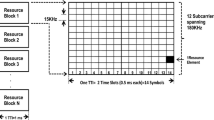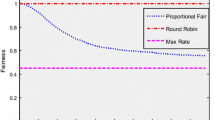Abstract
Long Term Evolution (LTE) mobile networks, time-frequency radio resources are allotted with respect to Quality of Service (QoS) requirements using scheduling algorithms. Buffer Occupancy (BO), Average Cellular Throughput (ACT), Average User Throughput (AUT), Blocking Probability (BP) and Fairness Index (FI) are the parameters to be considered when designing a scheduler. A new scheduling policy is proposed in this paper, called “Channel Aware Optimized Proportional Fair (CAOPF)” to optimize the channel behavior based on Channel Quality Indicator (CQI). The performance of the introduced scheduler is investigated and compared with the other schedulers such as Round Robin (RR) and Proportional Fair (PF). Simulation results indicate that the new scheduler gives the best level of QoS performance in terms of the above said parameters when compared with the other schedulers taken into account. It provides no pending data of users in good channel condition, higher ACT, higher improvement in user throughput in good and average channel conditions. In addition, very low blocking of user data in good channel condition and optimized FI and resource block (RB) allocated to the users in all channel conditions are seen.







Similar content being viewed by others
References
Kountouris M, Popovski P, Hou IH, Buzzi S, Müller A, Sesia S, Heath RW (2019) Guest editorial ultra-reliable low-latency communications in wireless networks. IEEE J Sel Areas Commun 37(4):701–704
Zhang C, Patras P, Haddadi H (2019) Deep learning in mobile and wireless networking: a survey. IEEE Commun Surv Tutorials
Luong NC, Hoang DT, Gong S, Niyato D, Wang P, Liang YC, Kim DI (2019) Applications of deep reinforcement learning in communications and networking: a survey. IEEE Commun Surv Tutorials
Mamman M, Hanapi ZM, Abdullah A, Muhammed A (2019) Quality of service class identifier (QCI) radio resource allocation algorithm for LTE downlink. PLoS One 14(1):e0210310. https://doi.org/10.1371/journal.pone.0210310
Elhadad MI, El-Rabaie E-SM, Abd-Elnaby M (2018) Capacity enhancement based on dynamically adapted PF scheduling algorithm for LTE downlink system. Int Arab J Inf Technol 15(5):795–801
Hong E-K, Baek J-Y, Jang Y-O, Na J-H, Kim K-S (2018) QoS-guaranteed scheduling for small cell networks. ICT Express, Elsevier BV 4(4):175–180. https://doi.org/10.1016/j.icte.2017.11.017
Elhadad MI, Abd-Elnaby M, El-Rabaie E-SM (2018) Optimized delay threshold scheduler for multimedia traffic over LTE downlink network. In: Multimedia tools and applications. Springer Science+Business Media, Springer Nature. https://doi.org/10.1007/s11042-018-6968-3
Pedro Junior Ashidani, Paulo Roberto Guardieiro (2013) Downlink scheduler based on deadlines for LTE networks. Proceedings of international workshop on telecommunications, Brazil, http://www.inatel.bt/iwt2013/index.php/component/cat_view/5papers?start=25, Accessed 4 Feb 2019
Bahreyni MS, Sattari-Naeini V (2014) Fairness aware downlink scheduling algorithm for LTE networks. Int J Math Comput Sci 11(1):53–63. https://doi.org/10.22436/jmcs.011.01.06
Habaebi MH, Chebil J, Al-Sakkaf AG, Dahawi TH (2013) Comparison between scheduling techniques in Long Term Evolution. IIUM Eng J 14(1):67–76. https://doi.org/10.31436/iiumej/v.14il.354
Hamdi MF, Saeed RA, Abbas AS (2018) Downlink scheduling in 5G massive MIMO. J Eng Appl Sci 13(6):1376–1381. https://doi.org/10.3923/jeasci.2018.1376.1381 Medwell Journals
Ouaissa M, Rhattoy A, Lahmer M (2019) Comparative performance study of QoS downlink scheduling algorithms in LTE system for M2M communications. Springer Nature Switzerland AG, pp 216–224. https://doi.org/10.1007/978-3-030-03577-8_25
Sundarasekar R, Shakee PM, Baskar S, Kadry S, Mastorakis G, Mavromoustakis CX, Vivekananda GN (2019) Adaptive energy aware quality of service for reliable data transfer in under water acoustic sensor networks. IEEE Access
Lawal MA, Saidu I, Mohammed A, Sade YA (2017) Downlink scheduling algorithms in LTE networks: a survey. IOSR J Mob Comput Appl 4(3):1–12. https://doi.org/10.9790/0050-04030112
Mae AE, Kwee WK, Han PY, Hoe LS (2016) Resource allocation for real-time multimedia applications in LTE’s two-level scheduling framework. IAENG Int J Comput Sci 43:4 IJCS_43_4_04
Mahfoudi M, El Bekkali M, Najid A, El Ghazi M, Mazer S (2015) A new downlink scheduling algorithm proposed for real time traffic in LTE system. Int J Electron Telecommun 61(4):409–414. https://doi.org/10.2478/eletel-2015-0054
Satheesh MB, Sivasubramanian A, Babu SPK (2017) A review of MAC scheduling algorithms in LTE system. Int J Adv Sci Eng Inf Technol 7(3):1056–1068. https://doi.org/10.18517/ijaseit.7.3.2059
Zhang Y, Hossain MS, Ghoneim A, Guizani M (2019) COCME: content-oriented caching on the Mobile Edge for wireless communications. IEEE Wirel Commun 26(3):26–31
Saeed N, Celik A, Al-Naffouri TY, Alouini MS (2019) Underwater optical wireless communications, networking, and localization: a survey. Ad Hoc Netw 101935
Baskar S, Periyanayagi S, Shakeel PM, Dhulipala VS (2019) An energy persistent range-dependent regulated transmission communication model for vehicular network applications. Comput Netw 152:144–153
Nguyen D-H, Nguyen H, Renault E (2016) A new channel and QoS-aware scheduling scheme for real-time services in LTE network. Int J Appl Inf Syst 11(4):1–8. https://doi.org/10.5120/ijais2016451601.hal-01360864
Heidari R, Afroz F, Subramanian R, Cong S, Sandrasegaran K, Kong X (2015) Packet scheduling study for heterogeneous traffic in downlink 3GPP LTE system. Int J Wirel Mob Netw 7(5):91–106. https://doi.org/10.5121/ijwmn.2015.7507
Paul AK, Kawakami H, Tachibana A, Hasegawa T (2017) Effect of AQM-based RLC buffer management on the eNB scheduling algorithm in LTE network. Technologies 5(3):59. https://doi.org/10.3390/technologies5030059
Jain R (1991) The art of computer systems performance analysis. Wiley, New York
LTE Quick Reference http://www.sharetechnote.com/html/Handbook_LTE_CQI.html. Accessed 6 Apr 2019
Venkataraman NL, Kumar R, Shakeel PM (2019) Ant lion optimized bufferless routing in the design of low power application specific network on chip. Circuits Syst Signal Process:1–16. https://doi.org/10.1007/s00034-019-01065-6
Capozzi F, Piro G, Grieco LA, Boggia G, Camarda P (2012) Downlink packet scheduling in LTE cellular networks: key design issues and a survey. IEEE Commun Surv Tutorials 15(2):678–700. https://doi.org/10.1109/SURV.2012.060912.00100
Author information
Authors and Affiliations
Corresponding author
Additional information
Publisher’s note
Springer Nature remains neutral with regard to jurisdictional claims in published maps and institutional affiliations.
Rights and permissions
About this article
Cite this article
Monikandan, B.S., Sivasubramanian, A., Babu, S.P.K. et al. Channel aware optimized proportional fair scheduler for LTE downlink. Peer-to-Peer Netw. Appl. 13, 2135–2144 (2020). https://doi.org/10.1007/s12083-019-00826-z
Received:
Accepted:
Published:
Issue Date:
DOI: https://doi.org/10.1007/s12083-019-00826-z




